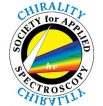What is Chiroptical Spectroscopy?
Chiroptical Spectroscopy is a form of spectroscopy in which one measures the difference in response of a chiral sample between left and right circularly polarized (LCP and RCP) light or radiation. The oldest form of chiral spectroscopy is called optical rotation in which the plane of polarized light is rotated (left or right)while passing through a chiral sample. A chiral sample typically is comprised of chiral molecules which have low enough symmetry that they cannot be superimposed on their mirror image. A chiral molecule and its mirror image are called enantiomers.
Chiroptical spectroscopy can distinguish between enantiomers because LCP and RCP are non-superimposable mirror images of one another and their difference (chiroptical spectroscopy) is. opposite for enantiomers. Thus chiroptical spectroscopy can determine of which enantiomer is present in the sample.
Beyond optical rotation (OR) there are a number of different forms of chiroptical spectroscopy. The next oldest is circular dichroism (CD), the difference in the absorption of a chiral sample for LCP versus RCP light. CD is usually measured in the region of the electronic transitions in a molecule that occurs in the visible or UV region of the spectrum. Here it is called electronic CD or ECD. When CD is measured in the infrared region where vibrational transitions occur it is call vibrational CD or VCD.
Another form of vibrational chiroptical spectroscopy or vibrational optical activity occurs in Raman scattering where the difference in Raman intensity for RCP and LCP light where it is called Raman optical activity (ROA). Because Raman scattering involved two light beams, the incident exciting (usually laser) radiation and the scattered Raman light, the difference in RCP and LCP tradition can be either on the incident light (ICP-ROA) or the scattered light (SCP-ROA) or both.
Other forms of chiroptical spectroscopy involve two forms of fluorescence spectroscopy called circularly polarized luminescence (CPL) and fluorescence detected CD (FDCD).
All forms of chiroptical spectroscopy can now be calculated using quantum chemistry programs and by comparing calculated and measured chiroptical spectra the enantiomer present in the sample can be identified. Such an identification is called determination of the absolute configuration of a chiral molecule.
Because chiroptical spectroscopy carries a 3D spatial sensitivity it can also be used to identify the shape or conformation of molecule which is very useful for biological molecules where the absolute configuration is given by nature but where its conformation in space controls its biological function and activity.
The most recent form of chiroptical spectroscopy occurs in the microwave region where it is called microwave rotational resonance (MRR). MRR applies to gas phase samples where there is a difference in phase for enantiomers between three coherent microwave beams, two incident and a third induced. At present MRR can distinguish between enantiomers for a given measurement configuration but predicting in advance the sense of the phase shift (positive or negative) has not been achieved.
